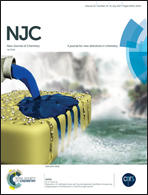Nanoceria supported cobalt(0) nanoparticles: a magnetically separable and reusable catalyst in hydrogen generation from the hydrolysis of ammonia borane
Abstract
Cobalt(0) nanoparticles supported on nanoceria (Co0/CeO2) were prepared from the reduction of cobalt(II) ions impregnated on the surface of ceria nanopowders. The magnetic Co0/CeO2 catalyst could be isolated from the reaction solution by using a magnet and characterized by using ICP-OES, XRD, TEM, EDX, BET and XPS techniques. The results reveal that cobalt nanoparticles with particle sizes in the range between 3.5 and 6.0 nm were successfully anchored on the surface of nanoceria. Co0/CeO2 is a magnetically separable and reusable catalyst in hydrogen generation from the hydrolysis of ammonia borane retaining its initial catalytic activity (TOF = 7.0 min−1) even after the fifth use. For comparison, other non-noble metal nanoparticles were also supported on nanoceria. Ni0/CeO2 and Cu0/CeO2 provide TOF values of 1.7 min−1 and 1.5 min−1, respectively, while Fe0/CeO2 is catalytically silent in the hydrolysis of ammonia borane at room temperature. The work reported here also includes the results of a kinetic study of the catalytic hydrolysis of ammonia borane depending on the temperature and catalyst concentration.



 Please wait while we load your content...
Please wait while we load your content...